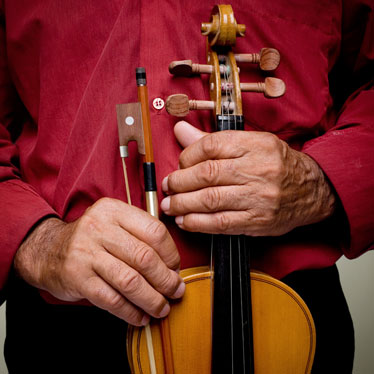Adult Beginners’ Finger Exercises for Violin and Viola

There is a plethora of information available regarding proper violin and viola technique – from postural recommendations to proper fingering and bowing. Those are all helpful, but strong, nimble fingers are foundational to your ability to adhere to those recommendations.
Even the daily repetition of the simplest and gentlest of exercises makes a noticeable difference in how fingers move – and feel – as they migrate up and down the fingerboard.
Purchase and use a hand therapy ball
Also called “stress balls,” hand therapy balls offer a range of benefits. In addition to reducing tension and stress in general, they simultaneously:
- Increase blood flow through the hand, wrist, and arm
- Strengthen muscles in the fingers, hands, wrists, and forearms
- Reduce symptoms of painful or debilitating conditions such as carpal tunnel syndrome and arthritis
- Reverse symptoms and side-effects of strain or daily overuse (like the kind that results from over-practicing on your violin or viola)
You can purchase hand therapy balls online. Once you have yours, use it daily. Squeeze it as tightly as you can without pain or discomfort and hold it for 5 seconds. Complete 10 repetitions, then switch hands and start again.
Flexor stretches
Flexor stretches are a great practice or performance warm-up, and they can also be done wherever you’re at (work desk, picnic, dinner table, on the dashboard while stuck in traffic, etc.).
Simply place one forearm on a flat surface, palm down. Use your other hand and gently pull the thumb and each finger up off the surface and back toward the wrist. Only go as far as the finger will let you without discomfort. Hold for a few seconds and then release.
Finger lifts
While your arm is already palm down, you can follow up your flexor stretches with some finger lifts. Comfortably spread your thumb and fingers so that as much of your palm/digits are in contact with the table. Then slowly extend them, one by one, trying not to let any other part of your hand (or the other fingers) lift off the tabletop.
Better yet, try doing a set of finger lifts before your flexor stretches set, and then repeat the finger lift series again afterwards. Do you notice a difference? Odds are you’ll be able to raise each finger a little higher the second time around because they’re more limber, and because your brain is making more specific connections – called muscle memory – about the muscle/connective tissue systems you’re repeatedly engaging.
Have arthritis? Hand exercises for arthritis help violinists, too!
Osteoarthritis (OA) is most common in adults 50 years and older. However, many younger adults develop arthritis in their thumbs, or a specific finger, as a result of occupational overuse. In any case, arthritis or other conditions affecting the connective tissue make joints, tendons, and ligaments more tender.
These 8 Daily Arthritis Hand Exercises, from creakyjoints.org, are all effective at reducing joint inflammation, stiffness and discomfort resulting from OA. Start using them every day and you’ll gain the added benefit of stronger, more flexible, and less painful playing fingers.
Don’t forget the pinky
Your pinky is going to have to work harder than ever now that you’re playing a string instrument, and it’s notoriously the weakest finger. Read our post about pinky strength exercises to help that little guy catch up to the rest.
A healthy diet and lifestyle may be just as important
The more physicians and scientists learn about inflammation and disease, the more they’ve correlated that healthy diet and lifestyle choices are excellent preventatives.
If you notice your joints and fingers are stiffer, swollen or more tender than usual – consider implementing the tenets of an antinflammatory diet into your routine. Multiple studies confirm that those who suffer from arthritis and/or joint pain experience notable improvements when they make the switch. Similarly, exercises such as yoga and Pilates can meet you where you’re at, while simultaneously improving your mobility and comfort – including when practicing and playing your violin.
After just four to six-weeks of committing to these adult beginners’ finger exercises on a daily basis, we promise you’ll notice greater comfort and fluidity as your fingers move along the fingerboard.
Sponsored by Thomastik-Infeld


